|
| Ping Shen Tao |
|
|
| Peaceful Spirit Way |

Ping
Shen Tao... The Name What
is "Ping" ? Lao Tzu noted that violence and conflict, no matter how tightly controlled, could not help
but cause negative side effects. The ideal is to solve problems through peaceful means. Ping can be Justice, Calmness, Serenity
and Tranquility, Or just "Peaceful". What is "Shen"?
There are more than just prerequisites to gain a physical understanding of our art, and to develop the ability to direct the
mind without "doing " at all. This includes the conscious and unconscious mind. It goes beyond technique, in which
the practitioner responds with sensitivity to a set of conditions, drawing on one’s full awareness. Maybe the highest
stage of development for a Martial Artist . Just simple put Shen could be said to be your inner " Spirit"
What is "Tao"? Tao is a universal principle
that underlies everything from the creation of galaxies to the interaction of human beings. The workings of Tao are vast and
often beyond human logic. In order to understand Tao, reasoning alone will not suffice. One must also apply intuition. (pronounced
"dao") means literally "the path" or "the Way." "Ping Shen Tao" as a maxim is profound to me. When one is provoked and irate, one can calm his or her heart
and quiet the mind to acquire serenity and tranquility. Life is growth. When we stop growing, technically and spiritually,
we are as good as dead. The true Art of "Ping Shen Tao" is not just to learn how to defend ones self but to relies
that life should be a celebration of the bonding of humankind not a fight for life. The PST way is all that is true,
good, and beautiful. "PING SHEN TAO" = "PEACEFUL
SPIRIT WAY" 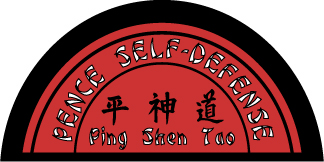 
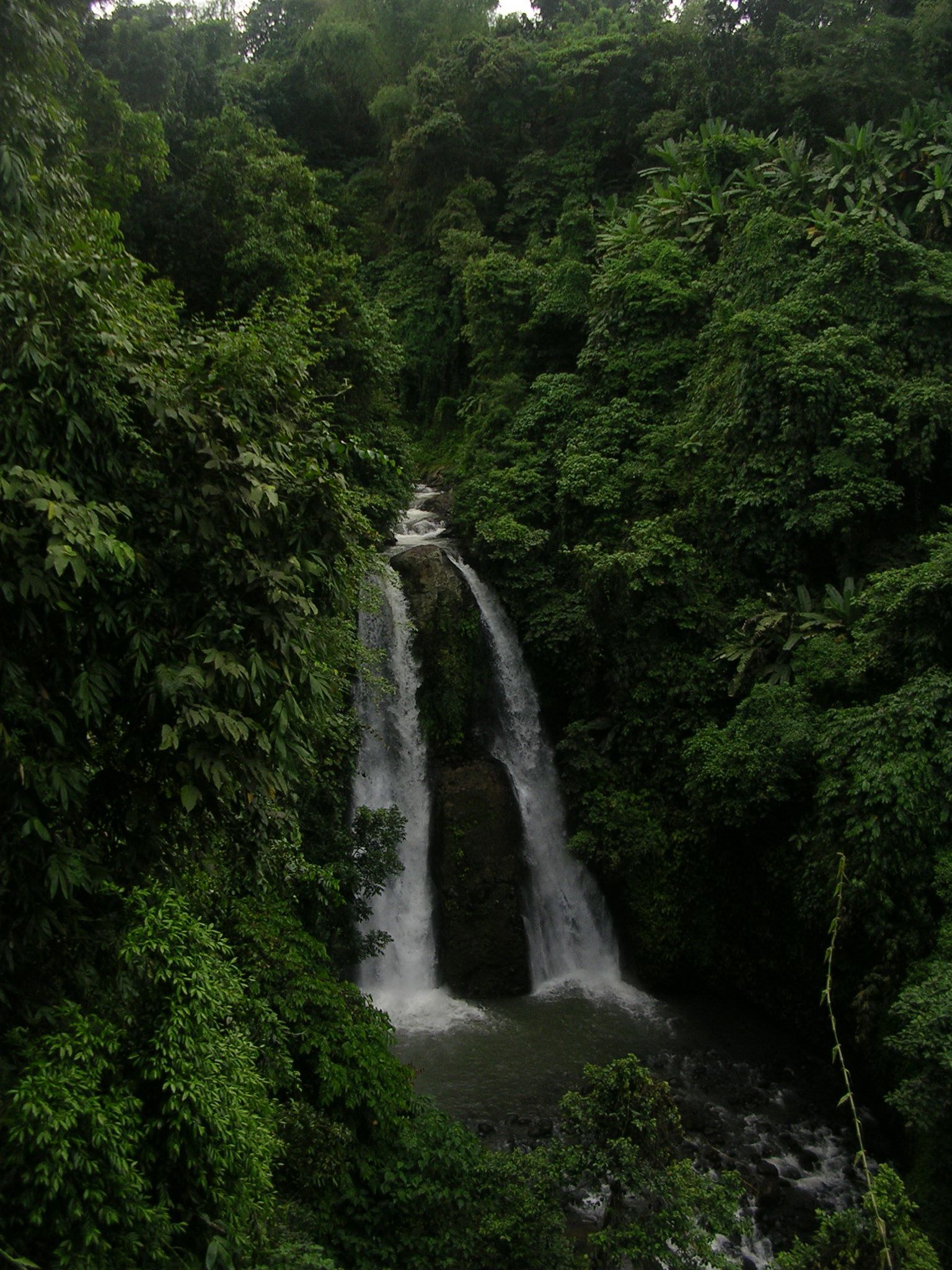 The Philosophy
of Ping Shen Tao By
Kevin Pence Sr. Sensei For
a person to be complete and happy with oneself, they must find a balance. If the body is in good health, then the mind may
function skillfully. For all to work together mind and body, we must employ our spirit. We don't criticize, we must try
to be patient, kind and understanding to others. Never too much, never too little, only what is necessary. At their most basic level, the martial arts are nothing more than ways to prevent someone from harming you. At their
highest level, the arts are paths to self-knowledge, brotherhood and the beauty of life. The martial artist must be both artist and scientist. We must learn the
traditions, techniques, principles, and theories upon which martial artistry is based. We must then practice them with passion so as to properly learn and understand
what it is we are doing. Only then can we master ourselves, our lives, and the Arts. Ping Shen Tao is both an external and an internal style that incorporates both
linear and circular techniques. In addition, much emphasis is placed on learning to more zone on your opponent energy and
learning to flow with whatever your opponent comes at you with. Stopping with one counter hit is not likely; students must
learn to flow until the situation is no longer a threatening one. When this is done; we have Ping Shen Tao. The martial arts are both art and science. It can be said that; Art is a passion pursued with
discipline; science is a discipline pursued with passion. Over my lifetime, I have created a successful teaching technique
that incorporates character building philosophies with traditional martial arts training methods. With younger students, the
art focus on helping them to understand and use the martial arts in order to develop discipline, self control, and respect. It also helps them to establish healthy
life style habits at an early age. With
older students, we enjoy sharing the intricacies of a modern martial way. Our unique style of traditional martial arts training
and modern workouts, plus stress reducing Chi Kung sets, allow individuals to gain the physical benefits, and confidence that
can only be achieved through effective self defense training. Basic meditation is also part of the curriculum as away
to help open ones mind to the learning process. Students are instructed in the ethics of the martial way, including loyalty
to nation and family, truthfulness, keeping ones word, and the necessity to "justify your means" when using force. In a Sparring competition or a street fight, the basic strategy
is the same to submit your opponent as quickly as possible while absorbing the least amount of punishment possible. Ping Shen
Tao teaches one to control an opponent, concentrating on balance, leverage, and technique to control ones opponent and ultimately
end all conflict. A fight
should Never last for more than few seconds. learning to control an attacker is the key to ending a fight quickly. If you
can't control a man, you can't submit him. And if you are finding yourself fighting, you are probably not controlling
your opponent properly. There are many set techniques but, there is much emphasize put on improvised problem solving. Sparring
emphasizes blocking and attacking at the same time along a center line strike points. When we must use our art to defend,
we "use the whole body as a weapon". This is not for everybody, it is sometime very brutal but, there is no question
that it is effective. Stated
in the simplest of terms, PST teaches you how to effectively and efficiently control and defeat your opponent. As the name
suggests Ping Shen Tao (Peaceful Spirit Way), peace come first. Thus, a PST practitioner must first learn to avoid problem
situations, as much as learn blocks, take-downs, controls, locks and positioning. To use your whole body as a weapon,
you must first learn control of yourself. Endurance and conditioning training is rooted in the basics of take downs, footwork
defenses, and joint control. These are the first concepts drilled. PST's goal is to cover all facets of fighting, ranging from striking, grappling, weapons
and incorporating all the different martial systems so that any given art may be countered. The main distinction between most
martial artist and the skilled in the PST way, is that there are no illegal holds. There is so much more to art than strikes,
arm bars and chokes... in real combat. We as martial artist should understand the science of body manipulation. Ankle locks,
knee locks, hip cranks, forearm locks, wrist traps, and neck cranks are all incorporated into the training. It doesn't
matter if you are on top, bottom, sideways, or on your feet. Once you understand the physiology behind any Art, you can apply
it from most any position, in a most crippling manner. In its ultimate form, PST is as much a psychological mastery as it is a physical one. You train
to bait your opponent and continuously control him. You train to trap your opponent from any position. You train to maintain
control by flowing into what they themselves are pulling or pushing themselves into... don't fight just flow from
beginning to end.
We as martial artist should always be on the look out for
what works and what does not, this is the only true way of the arts. This is why I have gone on to explore such arts
as Kali, Goju Ryu, Kobudo, Ju Jitsu, Silat and Shotokan to bring back what really works. Remember, "Ping Shen Tao is
not better than any other Art, it’s just some of the best of many Arts combined."
OUR MOTTO: By Kevin Pence Sr. Sensei For a person to be complete and happy with oneself, they
must find a balance. If the body is in good health, then the mind may function skillfully. For all to work together mind and
body, we must employ our spirit. We don't criticize, we must try to be patient, kind and understanding to others.
Never too much, never too little, only what is necessary. At their most basic level, the martial arts are nothing more than ways to prevent someone from harming you. At their highest
level, the arts are paths to self-knowledge, brotherhood and the beauty of life. The martial artist must be both artist and scientist. We must learn the
traditions, techniques, principles, and theories upon which martial artistry is based. We must then practice them with passion so as to properly learn and understand
what it is we are doing. Only then can we master ourselves, our lives, and the Arts. Ping Shen Tao is both an external and an internal style that incorporates both
linear and circular techniques. In addition, much emphasis is placed on learning to more zone on your opponent energy and
learning to flow with whatever your opponent comes at you with. Stopping with one counter hit is not likely; students must
learn to flow until the situation is no longer a threatening one. When this is done; we have Ping Shen Tao. The martial arts are both art and science. It can be said that; Art is a passion pursued with
discipline; science is a discipline pursued with passion. Over my lifetime, I have created a successful teaching technique
that incorporates character building philosophies with traditional martial arts training methods. With younger students, the
art focus on helping them to understand and use the martial arts in order to develop discipline, self control, and respect. It also helps them to establish healthy
life style habits at an early age. With
older students, we enjoy sharing the intricacies of a modern martial way. Our unique style of traditional martial arts training
and modern workouts, plus stress reducing Chi Kung sets, allow individuals to gain the physical benefits, and confidence that
can only be achieved through effective self defense training. Basic meditation is also part of the curriculum as away
to help open ones mind to the learning process. Students are instructed in the ethics of the martial way, including loyalty
to nation and family, truthfulness, keeping ones word, and the necessity to "justify your means" when using force. In a Sparring competition or a street fight, the basic strategy
is the same to submit your opponent as quickly as possible while absorbing the least amount of punishment possible. Ping Shen
Tao teaches one to control an opponent, concentrating on balance, leverage, and technique to control ones opponent and ultimately
end all conflict. A fight
should Never last for more than few seconds. learning to control an attacker is the key to ending a fight quickly. If you
can't control a man, you can't submit him. And if you are finding yourself fighting, you are probably not controlling
your opponent properly. There are many set techniques but, there is much emphasize put on improvised problem solving. Sparring
emphasizes blocking and attacking at the same time along a center line strike points. When we must use our art to defend,
we "use the whole body as a weapon". This is not for everybody, it is sometime very brutal but, there is no question
that it is effective. Stated
in the simplest of terms, PST teaches you how to effectively and efficiently control and defeat your opponent. As the name
suggests Ping Shen Tao (Peaceful Spirit Way), peace come first. Thus, a PST practitioner must first learn to avoid problem
situations, as much as learn blocks, take-downs, controls, locks and positioning. To use your whole body as a weapon,
you must first learn control of yourself. Endurance and conditioning training is rooted in the basics of take downs, footwork
defenses, and joint control. These are the first concepts drilled. PST's goal is to cover all facets of fighting, ranging from striking, grappling, weapons
and incorporating all the different martial systems so that any given art may be countered. The main distinction between most
martial artist and the skilled in the PST way, is that there are no illegal holds. There is so much more to art than strikes,
arm bars and chokes... in real combat. We as martial artist should understand the science of body manipulation. Ankle locks,
knee locks, hip cranks, forearm locks, wrist traps, and neck cranks are all incorporated into the training. It doesn't
matter if you are on top, bottom, sideways, or on your feet. Once you understand the physiology behind any Art, you can apply
it from most any position, in a most crippling manner. In its ultimate form, PST is as much a psychological mastery as it is a physical one. You train
to bait your opponent and continuously control him. You train to trap your opponent from any position. You train to maintain
control by flowing into what they themselves are pulling or pushing themselves into... don't fight just flow from
beginning to end.
We as martial artist should always be on the look out for
what works and what does not, this is the only true way of the arts. This is why I have gone on to explore such arts
as Kali, Goju Ryu, Kobudo, Ju Jitsu, Silat and Shotokan to bring back what really works. Remember, "Ping Shen Tao is
not better than any other Art, it’s just some of the best of many Arts combined."
OUR MOTTO:  “Avoid rather than check; check rather than block; block rather than
strike; strike rather than hurt; hurt rather than maim; maim rather than kill—for all life is precious.”
Nor Can any be replaced.
THE FIVE PRINCIPLES: SINCERITY, EFFORT, ETIQUETTE, CHARACTER,
SELF-CONTROL "
S.E.E.C.S." SINCERITY:Honesty
of mind and or intention: truthfulness. EFFORT:Putting forth an exertion of strength or power, physically or mentally. ETIQUETTE:The conventional code of good manners which governs behavior in society. CHARACTER: The
total sum of the qualities making up an individual: moral excellence. SELF-CONTROL: Control over one's own impulses, emotions or acts
I have always know these to be the five principles
of Kempo. I have put them in an order in our dojo as to have the students realize them in a way that follows suite with the
phrase or acronym "S.E.E.C.S.."
In
this order, the acronym SEECS must come from a practice of the following... First the Sincerity to the teacher that we want
to learn, then the Effort that it takes to learn the Etiquette, in turn we develop our Character and to maintain it takes
Self-control. While this is but one way to say it... it's our way.  
| Sky at dusk over the suger cane feilds in Negros |

|
The 8 Rules
of " Ping Shen Tao" 1. Rule of "The Matador" The best block you ask... don't
be there". Our art emphasizes economy of motion. The Matador principle teaches you to avoid being struck by use of foot
work. Foot work is your best line of defense in many cases. It's much better to move out of the way and simultaneously
counterattack but, move we must. The rule does not mean no blocking. PST teaches many blocking systems and dozens of trap
sets. When employed with the foot work we become a hard target. Remember be the Matador. Olay! 2. Rule of "The
First Strike" This Rules meaning is to say, if a confrontation is inevitable, You should not wait for the aggressor to attack first.
You need to hit him first fast and hard and continuously until he downed or the threat is no more. this may sound somehow
unhonorable but the truth is if you are sure the attack is coming your best defense is a good offense. It must be stressed
that this Rule is to be invoked Only if a confrontation is inevitable. 3. Rule of "The Machine Gun" A machine gun
is designed to fire bullets as long as the trigger is held down and ammunition is fed into the weapon. PST is different from
many styles in that it teaches you to strike first (when needed) and strike often in rapid succession. One strike loads the
next and so on. Bullet in the chamber and fire. 4. Rule of "Lumber Jack" This principle teaches us to
chop low at the tree before trying to push it over, if he is well rooted this task is not possible without this rule. PST's
teaching to kick the low lines is based on line of site. It is also very hard to see a low line of attack to the leg in a
close in situation, making it hard to counter. High kicks take longer to execute and are easier to counter as they expose
your weaknesses to your opponent. Kicking low to the legs, executing a "Lumber Jack attack" can break your opponent's
balance, then we may push them over with much more ease. Be the Lumber Jack. 5. Rule of "The Bulls-eye" Aim at a dime
size target and you will come close enough to do the damage needed to be done with the fight. Precisely targeting the Eyes,
Neck, Kidneys, and Groin are far superior to simply pounding away on random the body. If you had to punch a hole through a
wall, would you rather hit a half-inch of sheet rock, or a 2x4 wall stud? PST teaches the path of least resistance. We teach
striking Soft targets with our hard and hard targets with your soft. The target must be specific to the damage that is needed
to be done and not any more 6. Rule of "The Open mind" This rule of is based on flexibility.
It's the rule of "use what is good for you and that is all". Your art should adapt to your build, age, and spirit.
In a fight for your life you should use what you know best and forget about the style. Every practitioner has different attributes
that make them effective. The rule of open mindedness allows them all to develop their own repertoire of techniques from within
all the arts that make-up P.S.T. 7. Rule of "The Yin & Yang " The symbol of Yin & Yang
is best exemplified in the art of PST by the word Redirecting. When your opponent attacks hard, you should counter attack
soft. If they attack soft, you should attack hard to end the attack. PST also teaches you to block soft and strike hard. Flow
is what we look for in PST, from block to counter to trap to lock to escape. Be like the river, strong, yet flowing. 8. Rule of "The
Spirit" The final rule of PST is composed of two components: the Internal and External. To have a warrior spirit,
you must be ferocious on the outside but calm on the inside. To fight with anger takes more energy than we want to spend.
We must stay cool on the inside. When used in this way, your spirit can be your most important skill.

"What Arts make up Ping Shen Tao ?"
In general OUR, Kempo consists of
Okinawian, Japanese and Chinese based arts. Shaolin Kempo Karate, American Kenpo, and San Chai Na
Kempo. It is the base of the art we teach. Our Kempo has 1 thru 40 combos plus a numerous amount of punch
and kick techs. Our Kempo has numbered Pinan 1-5 and Kata 1-6 forms. Numerous other forms have
also been added to our systems such as Statue of the Crane, Hun suki, Sho tung kwa, Baisi Dai, Nafachin shodan-hachidan,
and Swift Tigers.
 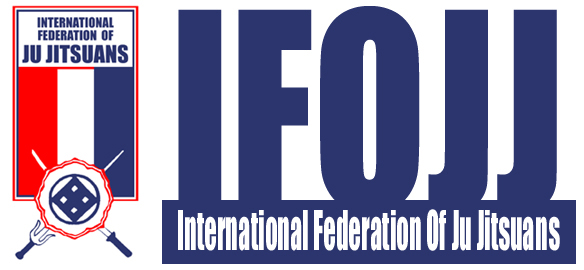 
Our Jiu-jitsu's combo's will work
your skills to escape from grabs and holds. The techniques will teach you how to trap, lock and control your attacker. Training
is practical with a heavy emphasis on drills and mock combat. Ju-jutsu was almost lost. However, some masters continued
to practice their art "under-ground", or moved to other countries, allowing the style to continue. By the mid twenty century,
the ban on the art in Japan had lifted, allowing the free practicing of the style.
We are proud members of the IFOJJ spear
headed by Ni-Dai Soke Michael Depasquale Jr. of the Yoshitsune JuJitsu clan.
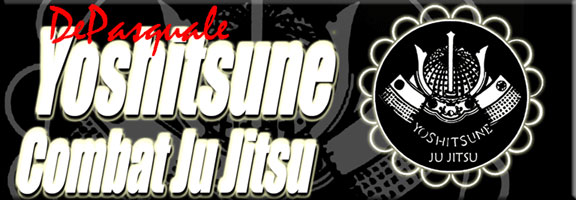
 
(Shaolin Wu Hsing
Chaun Fa)
the order of the following is the order this system is taught in . Frist the Tiger then
the Crane and so on.........
The Tiger is
the cornerstone of the system, Shaolin Chaun Fa. From the Tiger we learn strength and tenacity. The Tiger employs powerful
upperbody movements to overwhelm its opponents . Clawing, ripping , tearing and grappling are characteristic tactics of Tiger
style fighting.
The
Crane teaches grace, balance and coordination of the entire body. Crane-style fighting combines evasion with deadly
counter attacks to avoid injury and quickly incapacitate an opponent. Crane techniques are extremely powerful, employing the
entire body to generate force.
The
Snake teaches rhythmic endurance, focus and penetrating internal power. The fighting techniques of the Snake employ
both hard (external) and soft (internal) power. The Snake uses circular movements of the arms and legs with rigid, penetrating
and focused strikes with the hands and feet.
The
Leopard develops power from its great speed, balance and muscle development. The Leopard techniques are characterized
by loose, whipping movements that are delivered at great speed.
The Dragon combines
the fighting techniques of all of the other animals and adds the quality of Spirit strike with purpose and focus. The Dragon
teaches us to "Ride The Wind" ie flow from one technique to another, the Dragon adds its total of Mind, Body and Spirit. Above
all the Dragon teaches commitment, purpose and focus.
  Kobudo is a Japanese term which can be translated as "old martial way." Within Japan, it generally
refers to any traditional martial art but outside of Japan it generally refers to several different weapon traditions of Okinawan
origin.Some of the original Okinawain Kobudo including Tonfa, Sai, Kama, Bo, Jo, Nunchaku ,and Katana.
Modern Kobudo was founded by Shinko Matayoshi (1888-1947), born in the Naha region from a wealthy family. His
kobujutsu training began in his early teens and included kobujutsu, kamajutsu, ekujutsu, tonfajutsu and nunchakujutsu. At
the age of 22, he ventured into Manchuria by way of northern Japan. There he joined a team of mounted bandits and learned
several other weapons arts, including the bow and arrow, all from horseback making them unique from other Okinawan Kobujutsu
styles. Later, after returning to Okinawa, he traveled to Fuchow and Shanghai were he learned even more weapons arts in addition
to acupuncture, herbal medicine and another form of Shaolin boxing.
Shinko Matayoshi, along with Gichin Funakoshi, was
the first to publicly demonstrate Okinawan kobudo to mainland Japan in 1915. With the 1921 royal visit of Emperor Hirohito
on Okinawa, Matayoshi performed kobudo at a demonstration with Naha-te master Chojun Miyagi.
Nunchaku
The nunchaku is a double-pieced hardwood weapon. The separate pieces of wood are
hinged by silk cords or chain, end- to- end, by a universal point that permits freedom of swivel. Each piece is identical
in shape, being about one foot to fourteen inches in length and of round, hexagonal, or octagonal cross section. Each piece
may be of one diameter for its entire length, or may be tapered.
Sai
- The sai is primarily a defensive weapon. It has always been a truncheon, never a blade
weapon. the sai may be used to deflect, block or parry a cutting or stroking attack of a bladed or staff weapon. Three sai
are usually carried, one in each hand and one thrust through the belt or sash of the user. The third one is to replace one
that might be lost in combat, or may serve as a projectile weapon.
-
- Rokushakubo "aka" The Bo
- Rokushakubo is the name of this weapon as well as well as a fighting system. In Japanese
roku means "six,"shaku is a measurement of unit of about one foot in length, and bo means "staff". As its name implies, it
is a hardwood polelike weapon about six feet in length. The Okinawan bo have tapered end, the diameter from between one inch
and two inches.
Kama
The sickle was an agricultural tool. This tool has been used as long as rice has been
grown but was not long before it was used as a weapon. On Okinawa the sickle is called a kama. Kama tactics are primarily
Okinawan. The hardwood handle is slightly larger at the butt end to keep the weapon from slipping out of the users hand. Kama
attacks are chopping, hooking, hacking, blocking,deflecting, or covering actons against the enemy.
Tonfa
The wooden handle normally wedged into a hole in the side of the millstone serves their combat purpose
well. This handle, known as the tonfa consisted of a tapered shaft of hardwood fifteen to twenty inches long. To this shaft
was affixed a cylindrical grip projecting at right angles from the shaft at a place five or six inches down from the larger
end of the shaft. It was held by grasping the short grip loosely but firmly so it could not drop out of the users hand. With
the tui-fa lying along the undersides of the forearms so that the short projection beyond the grip extended foreward toward
the enemy.
Jo
The jo is wooden staff 48 to 50 inches In length and tapering like a bo. The jo is normally
manipulated with both hands; however, it is sometimes used with one with one hand. The jo is a close quarters combat weapon,
where a bo may be too long.
Chinese weapons taught include Spear, Shaolin Broad Sword (Dao), Butterfly swords.
 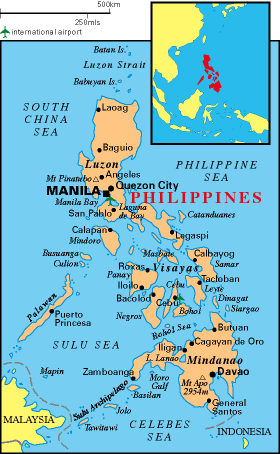 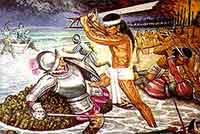
Kali - Arnis -Escrima
Kali, an ancient Philippine martial art, which is also known by other names, such as Escrima,
Arnis, Arnis de Mano, and FMA (Filipino Martial Art). By the 16th Century, Kali was a highly developed, warrior art which
was used against the invading Spanish. Primarily a weapon based art, Kali is a complete defense system. Kali features numerous
rapid-fire hand strikes along with kicks, knees, elbows, throws, weapons disarms, and locks. Dating back to the 1500’s,
during the colonization of the Philippine Islands by the Spanish. Many believe that Kali originated from Chinese influenced
Indonesian fighting tactics such as Kun Tao, and Ch’uan Fa. This art began to develop into a more martial discipline
when the Spanish prohibited indigenous Filipino weapons such as the Bolo (machete), daggers and fighting sticks in the late
1600s. The Rattan stick is the most common weapon used in Kali training, Other weapons include burned and hardened stick made
of hardwood, such as Kamagong. The footwork enables efficient control of ranges. The footwork is demonstrated in terms of
triangles with two feet occupying two corners of a triangle and a step to the third corner. Because of its effectiveness,
Kali is also taught extensively in the Army’s Special Forces & the Navy Seals. Emphasizing continuous flow and sensitivity
over strength, it is a Highly functional Art. This Art is taught in real world settings without a need for uniforms. Training
in the stick arts is not always what it may seem, I think many people are shocked to here that most Kali systems are meant
for the use of the blade but, most use the baston to train with for safety purposes. The practitioner learned to use all the
weapons that they might have to face. So while we do learn how to use edged weapons in our dojo it is also to learn how it
may be used to hurt us. Fore to know the weapon, is to also know it's weaknesses. When ever possible we would like to take
the weapon away from the attacker but the truth is that it is easier to avoid the cut and do your job as a striker first and
then when possible disarm. This is to say that we should not just expect to simply trap his blade hand and strip it away,
it takes some distraction and disabling first and alot of training... alot of training.
FBI Statistics have reported; Edged weapon attackers are responsible for 3% of all armed
attacks of police. Firearm attacks account for 4% . Having this in mind... Officers shot; 10% die from their wounds. Officers
stabbed; 30% die from their wounds. Edged Weapon Study; students learn short, long and medium range knife fighting. Double
and single blades are employed to inflict non-lethal and sometimes lethal results on an enemy. Knife to knife fighting is
emphasized, with many drills that help a student deal with a wide array of counters. Learning to use Edged weapons better
enables us to defend against them. Impact Weapon Study;The single stick is emphasized and the usage of double sticks is addressed
with sets for solo practice or with a training partner. This is a great way to make your hand lightning fast, fore when you
drop the sticks your hands have developed and speed in the process. Empty Hand Study; Students learn to use every part of
the body as a weapon to takeout an enemy. The use of the knees, shoulders, head, hands, feet, fingers are emphasized.

My Family's Martial Crest (EXPLAINED)
This Crest
was first made in 2001 and read "Pence Defense Kempo" but in 2005 changed to "Pence Self Defense"
to more accurately describe the Family Art as there are many Arts used to develop our students.
- The two hands we sometimes
call "peace over power" , (the closed fist for the power, and the open to symbolize peace.)
- The open top hand over the fist is for the peaceful side of the
art. We show the hand wraped down to show respect for those who have trained before us and for the restraint we take in using
the art.
- The
closed fist is to symbolize the power of the arts, and the hidden secrets within all styles of combat.
- The three triangles are for the unity of mind, body, and sprit.
The tigers open mouth is to symbolize the passing on of the arts and the true history of our's.
- The Ying and Yang is symbolic of the cycle of life, as well as
the soft and hard in the arts.
The positive side of the ying and yang symbol is thought of as the rising sun and is
a reminder that everyday is a gift; use it to live well and to help others.
- The negitive side of the yin and yang symbol is thought of as the
past, it is where our arts have came from and is a reminder not to forget our history and lineage.
 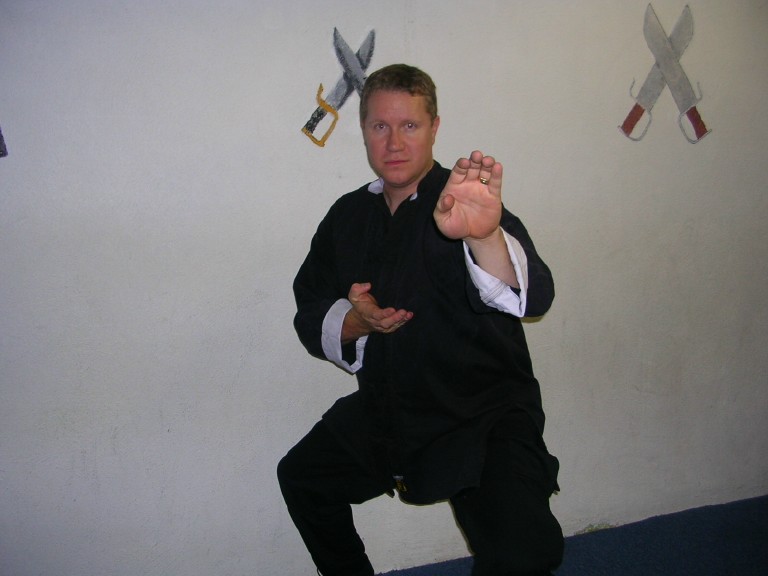 "Ping Shen Tao" as a Maxim In our day to day life we are
always faced with conflict, and it's how we deal with these issues that becomes the way we are judged by our friends,
family, and co-workers. It's just a fact. None of us need any of this stress in our lives, yet there it is time and
time again. Peace
over power Is the whole idea. to solve issues in a manner all can walk away from feeling that they haven't lose face".
There is never good in hurting another being, stronger or weaker, physically or mentally. When we are provoked or baited we can choose to calm our heart and quiet
the mind to acquire tranquility and stillness of intent. This is the time to stop and think before you act. Most of us just
re-act instead of taking that few extra seconds that it could take to make the right choice. Do not confuse the name of the art and its peaceful
nature as a unwillingness to defend ones self. Peace over power is always first but, not always last. We as practitioners
of Ping are bound never to use our art in an indiscriminate manner. A true practitioner of my art will do all that can
be done not to fight. At the same time, they should be someone who has resolved to take action in the face of mortal
danger and should anyone attempt to harm them or part of their Family, the attacker will be confronted
by a highly trained and committed fighter! We are the good guys first and foremost. The best student to teach is the one who feels the strongest about keeping peace. If a student doesn't
understand this, then don't teach them. The thing to remember is that we do not learn to attack, but to defend. We do not act, we react. We do only
enough to stop the enemy's attack. Once their attack is thwarted and they have stopped, we cease. If we continued to fight,
we'd no longer be defending ourselves, we'd just be assaulting them. The attack itself we react to, after it's
over, it's in the past and we have no right to attack anymore. So there's an element there of control as well as mercy.
We attack the attack, not the attacker. However, in that response to the attack we may avoid, check, we may hurt, or maim,
depending on the situation and the threat level. But we are reacting to an attack, not instigating one. That's the important
thing. We would be wise to simply not be
there, run, Get away, but if an innocent is knocked to the ground, hurt, or unconscious, they can't run. So to defend them I have to use my training until the
injured can recover and run. Or if they're unconscious or hurt, we may have to fight until the enemy are incapacitated.
I've always thought of my art as not only to defend myself but also focus my training on the idea that I will
use it to defend someone else who may not be able to defend themselves. “Avoid
rather than check; check rather than block; block rather than strike; strike rather than hurt; hurt rather than maim; maim
rather than kill—for all life is precious.” Nor Can any be replaced In our day to day life we are always faced with conflict, and it's
how we deal with these issues that becomes the way we are judged by our friends, family, and co-workers. It's just a fact.
None of us need any of this stress in our lives, yet there it is time and time again. Peace over power Is the whole idea. to solve issues in a manner
all can walk away from feeling that they haven't lose face". There is never good in hurting another being, stronger
or weaker, physically or mentally. When
we are provoked or baited we can choose to calm our heart and quiet the mind to acquire tranquility and stillness of intent.
This is the time to stop and think before you act. Most of us just re-act instead of taking that few extra seconds that it
could take to make the right choice. Do not confuse the name of the art and its peaceful nature as a unwillingness to defend ones self. Peace
over power is always first but, not always last. We as practitioners of Ping are bound never to use our art in an indiscriminate
manner. A true practitioner of my art will do all that can be done not to fight. At the same time, they should be
someone who has resolved to take action in the face of mortal danger and should anyone attempt to harm them or part
of their Family, the attacker will be confronted by a highly trained and committed fighter! We are the good guys first and foremost. The best student to teach is the one who feels the
strongest about keeping peace. If a student doesn't understand this, then don't teach them. The thing to remember is that we do not learn to
attack, but to defend. We do not act, we react. We do only enough to stop the enemy's attack. Once their attack is thwarted
and they have stopped, we cease. If we continued to fight, we'd no longer be defending ourselves, we'd just be assaulting
them. The attack itself we react to, after it's over, it's in the past and we have no right to attack anymore. So
there's an element there of control as well as mercy. We attack the attack, not the attacker. However, in that response
to the attack we may avoid, check, we may hurt, or maim, depending on the situation and the threat level. But we are reacting
to an attack, not instigating one. That's the important thing. We would be wise to simply not be there, run, Get away, but if an innocent is knocked
to the ground, hurt, or unconscious, they can't
run. So to defend them I have to use my training until the injured can recover and run. Or if they're unconscious
or hurt, we may have to fight until the enemy are incapacitated. I've always thought of my art as not only to
defend myself but also focus my training on the idea that I will use it to defend someone else who may not be able to
defend themselves. “Avoid rather than check; check rather than
block; block rather than strike; strike rather than hurt; hurt rather than maim; maim rather than kill—for all life
is precious.” Nor
Can any be replaced
 A
final note to all... Class-time is where we
not only train, but we better ourselves, support each other, challenge one another, and become skilled. This art is effective
in a myriad of situations and scenarios with simple techniques for the practitioner, but most of all it teaches the practitioner
to be adaptive to situations, and respond quickly to threats. My goal is to spread the art of Ping Shen Tao to as many people
as possible. I have been a practitioner of the arts most of my life and have never lost my love or fascination for the martial
arts diversity. Truly, this is an art that anyone can learn and be effective in. I spend time training each and every student, and get to know everyone I train. I take interest in the development
of all students that train with me, and has a desire to learn the art. I will teach the student the techniques of P.S.T. along with the theory of how each technique
works and why. What I try to give is a deeper understanding of how the art works, and not just a series of motions that could
work in the right case. To give the students more than just technique and form, but also style & effectiveness, that is
my aim. False prophets and frauds promising salvation
abound in all endeavors, from businesses, to religion, to martial arts. I claim to be nothing but a man who has found a love
for passing on the good that I have received from other great martial artist from around the world. Along with the love of
my family, it is what drives me and completes me. It
took a life time for me to name my art, the way I think of it, the way I trian, the way I share it. Maybe because I finally
found the peace I was looking for. Yours in the Arts KP
  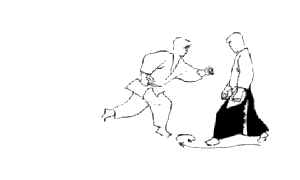  |

